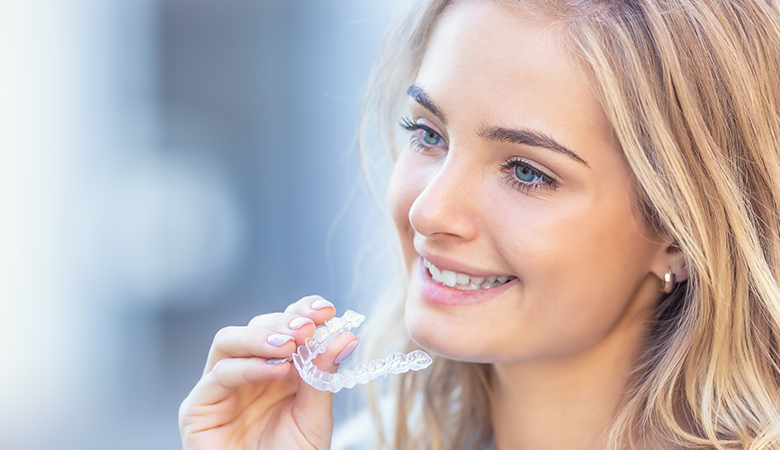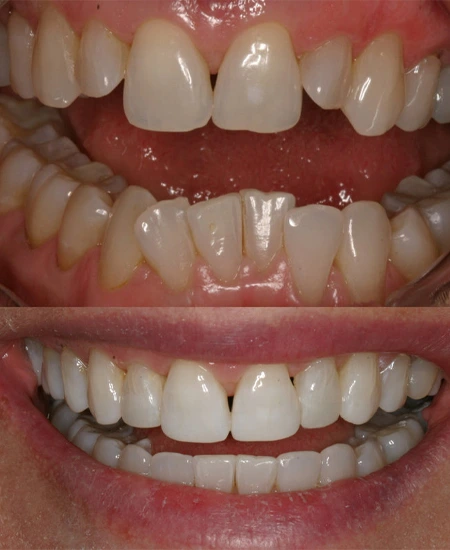INVISALIGN® IN CORAL GABLES, MIAMI, FL
Invisalign®
Dr Abadin is Miami/Coral Gables premier Invisalign Dentist.
Dr. Abadin has treated over 2000 cases and has gained extensive knowledge and expertise from doing Invisalign cases for over 15 years. As an Invisalign Diamond provider, during your treatment Dr. Abadin can accelerate your case and provide you with the smile you have always wanted utilizing clear aligners in a fast and predictable manner. Most cases are completed in as little as 4-6 months!
Designed with the iTero digital technology, a series of clear plastic trays produce the straightening results. Medical-grade plastic without wires, metal, springs, or rubber bands gently move your teeth into place. Gradual pressure on specific teeth with each aligner means less discomfort and in many cases treatment can be shortened to half the time with Dr. Abadin’s expertise.


Invisalign trays are recommended to be worn 22 hours a day, they may be set aside for short periods allowing normal eating, brushing, and flossing. Enjoying an apple without the intrusion of brackets and wires works well for many patients. And the smooth plastic surface offers a comfort level to the tongue and cheeks unequaled by other forms of straightening. While clear aligners work extremely well for adults, a responsible teen may be a candidate too. Patients of all ages have discovered the perks of straight teeth with Invisalign.
Using 3D scanning and high technology teeth straightening software, a series of comfortable and transparent trays are produced that when worn produce an amazing smile and improve results.

Invisalign is the most well-known brand of clear aligners on the market. They were introduced in 1998 by Align Technology. The idea came about because one of the founders of the company was completing orthodontic treatment. Upon receiving his retainer, he decided that it should be possible to create a system of clear aligners that could mimic the results of traditional braces.
Invisalign clear aligners are FDA-approved for the treatment of malocclusion and are made from medical-grade, BPA-free plastic. This thermoplastic material is known as SmartTrack and according to the company, it is more discreet, comfortable, and accurate.
The aligners should be worn for 20 to 22 hours a day and can be removed for cleaning, eating/drinking, and brushing.
Who should go for Invisalign?
Invisalign was designed to provide patients with teeth straightening without the need for braces or oral surgery. It was introduced in 1998 and continues to be one of the most popular choices among teens and adults to fix overcrowding, crooked/uneven teeth, gapped teeth, and misalignment.
If you have concerns about the efficacy and efficiency of Invisalign, schedule an appointment with Dr. Abadin and the team at Abadin Dental. We can explain everything you need to know about this treatment and which patients should consider it.
Which conditions does Invisalign treat?
Invisalign has proven effective at treating the following dental conditions:
Overbite
Overbite is a condition in which the upper teeth overlap the lower teeth. This can make it difficult to chew/bite some foods. Invisalign can shift the teeth so that the top and bottom arches align properly when your mouth is closed.
Crooked Teeth
If your teeth are crooked, Invisalign can help. However, if your teeth are severely rotated, you may be advised to start with traditional braces and then switch to Invisalign once the affected teeth are straighter.
Underbite
An underbite is where the lower teeth overlap the top teeth. It can cause difficulty speaking and cause your teeth to wear quicker. Invisalign can move your bottom teeth backward, so the two arches are aligned when your mouth is closed.
Gapped Teeth
Gapped teeth is one of the most common orthodontic issues. When you have gaps between your teeth, food may become stuck between the teeth and gums, which causes discomfort/pain, and ultimately may lead to gum disease. Invisalign can shift your teeth to fill in those gaps.
Open Bite
An open bite is when the top and bottom teeth do not touch when the mouth is closed. It may occur in the front or back, but a frontal open bite is the most common. Invisalign can shift the top and bottom teeth into the proper position so that they touch when the mouth is closed.
Crossbite
A crossbite is when one or more of the top teeth fall behind the bottom teeth. It can be in the front (anterior) or back (posterior). Approximately 4% to 5% of the population has an anterior crossbite. Approximately 16% of the population has a posterior crossbite. Invisalign can usually bring the teeth into alignment. However, severe cases may require surgery or other orthodontic treatments for best results.
Crowded Teeth
Crowding is when the teeth are overlapped and twisted because there is not enough space in the jaw for all of them. Invisalign can fix mild to moderate cases of crowded teeth. If the condition is severe, tooth extractions or other treatments may be required.
What can Invisalign not do?
While Invisalign can do a lot to straighten your smile, there are a few situations in which traditional braces may be recommended instead:
Tooth Shape
For some patients, their tooth shape makes it difficult for them to use aligners. If your teeth are short, pegged, sharp, or round, the aligners may not be able to grab them and will therefore be ineffective.
Tooth Position
If your molars are rotated more than 20 degrees, Invisalign will not be effective. For incisors, premolars, and canines, the rotation can be greater. Also, if teeth are tilted greater than 45 degrees, Invisalign will not be able to raise them to the proper position.
Intrusion/Extrusion
Traditional braces can move teeth up/down in the jawbone to maintain height. Invisalign can only slightly move the front teeth and cannot move the back teeth.
Previous Dental Work
If you have crowns, porcelain veneers, or a dental bridge, Invisalign will not work for you.
Invisalign vs Braces
While Invisalign and traditional braces are both orthodontic treatments that bring teeth into proper alignment, this is where the similarities end. There are some significant differences between the two when it comes to the following:
Cost
Cost varies and depends on several factors. The average cost of traditional metal braces is $3,000 to $7,000. Insurance does usually cover at least a portion of traditional metal braces. The cost of Invisalign is similar, but due to the various treatment levels, the range is wider: $1,200 to $8,000. Insurance may not cover any of the cost of Invisalign. The duration of treatment and the complexity of your malocclusion will determine your final cost.
Our office staff will work with your dental insurance to determine coverage. We will also provide you with information on our financing options: GreenSky, CareCredit, and Lending Point.
Appearance
Traditional braces stand out. The brackets and wires are visible to everyone who looks at you. This is why so many teens and adults prefer Invisalign. The aligners are made from transparent plastic that is virtually invisible. Plus, they fit snugly against your teeth, so most people won’t even notice them.
Comfort
Traditional metal braces cause more pain and discomfort than clear aligners- especially when treatment is just starting. The brackets and wires scrape against the inside of your cheeks and lips, causing sore spots- while Invisalign is softer and smoother. The aligners will take some time to get used to, you may have a lisp for the first few days and increased salivation.
Effectiveness
The FDA has approved traditional braces and Invisalign clear aligners for treating orthodontic issues. Typically, Invisalign is reserved for mild to moderate cases and traditional braces are used in more complex cases, especially if there are large gaps, rotated teeth, or significant crowding.
Most patients see results with Invisalign within 12 to 18 months. Some achieve full results in 6. Traditional braces usually take 1 to 2 years. The length of treatment varies, depending on the complexity of your situation and your compliance with wearing the aligners. Discuss your needs with the team at Abadin Dental.
Food Restrictions
Patients with traditional braces must avoid certain foods, such as carrots, candy/gum, popcorn, apples, nuts, and pears. This is because they can damage or stick to the brackets and wires.
Invisalign clear aligners can be removed while eating/drinking, so you’re not restricted to what you can eat. However, you must brush/floss your teeth after and rinse the aligner before putting it back in to avoid tooth decay.
Care/Cleaning
If you have traditional braces, you need to brush your teeth with an interdental brush after every meal or snack and brush/floss every morning and evening. Invisalign aligners can be removed when brushing/flossing. Make sure to wash the aligners with a special cleaning solution to avoid calcium and bacteria buildup.
Procedure
Both treatments begin in the same way: with a comprehensive dental exam and x-rays.
If you’re getting traditional braces, the brackets will be secured to your teeth and a wire threaded through them. They are held in place with rubber bands. Patients with traditional metal braces require more follow-up visits so the braces can be tightened and adjusted. You will be required to wear a retainer for 1 to 3 years once the braces come off.
If you’re getting Invisalign, a mold will be made of your teeth so the lab can create your trays. The trays are custom-made for your mouth. Once the trays are ready, Dr. Abadin will place the first one to ensure it fits properly. Then, you will be sent home with the remaining trays and instructed to switch to a new set every few weeks. The aligners must be worn for 20 to 22 hours a day- if you’re not wearing them, you can’t expect them to work.
Invisalign Cost
The cost of Invisalign is comparable to that of traditional metal braces. Several factors determine the cost of Invisalign, including the complexity of the malocclusion and the length of treatment. At Abadin Dental, we have four levels of treatment available:
- Express
- Lite
- Moderate
- Comprehensive
Patients with mild malocclusion can use the Express level of treatment. The cost ranges between $1,200 and $2,000 and you can get 5 to 7 aligners, depending on your needs.
The Lite and Moderate treatment options work well for patients with moderate malocclusion. Lite is best for mild to moderate cases and costs $3,000 to $4,500 for up to 14 aligners. On the other hand, Moderate is best for moderate cases and costs $3,500 to $5,000 for up to 20 aligners.
The Comprehensive level of treatment is for patients who require significant alignment. It costs between $4,500 to $8,000 and offers unlimited aligners.
Invisalign for Teens
The primary difference between Invisalign Teen and Invisalign for adults is a series of blue dots. These blue dots are helpful for parents who are concerned about whether or not their teen is wearing the aligners like they’re supposed to. If they are being worn properly, the dots will fade.
Invisalign Teen offers several benefits and drawbacks.
Benefits
Invisalign clear aligners put pressure on the teeth to shift them into alignment, just like traditional braces. Each set is worn for 1 to 2 weeks before being changed out to a new set. Some of the benefits of Invisalign Teen include:
- Easier to brush/floss
Oral hygiene can be difficult when you have traditional braces. Invisalign can be removed so it’s easier for teens to keep their teeth clean and prevent plaque buildup. Therefore, their risk of cavities is reduced.
- Improves self-esteem
Many kids and teens pick out the one thing that makes someone different and use it to bully them. Metal braces are one of these things that they may be teased over. Invisalign aligners are nearly invisible, so unless they tell someone, most people won’t realize they have them.
- No sore spots
Traditional braces can cause sore spots from the wires and brackets rubbing against cheeks and lips. This isn’t a problem with Invisalign.
- No broken wires/brackets
The wires/brackets in traditional braces get broken for various reasons. This won’t be an issue with Invisalign, since there are no wires/brackets to worry about.
- Drawbacks
The team at Abadin Dental wants you to also be aware of the potential drawbacks associated with Invisalign Teen.
- Results are mixed
While Invisalign is effective for some teens, it’s not effective for others. This could be due to a variety of reasons. Therefore, even after completing Invisalign treatment, your teen may still need other treatments.
- Requires teens to be responsible/compliant
Invisalign aligners must be worn to be effective. If your teen doesn’t follow directions very well, Invisalign may not be the best option for them. The aligners must be worn for 20 to 22 hours a day, even while sleeping. They can be removed for eating, drinking, and brushing/flossing teeth, but must be put right back in.
- Insurance may not cover treatment
Orthodontic treatments in general are expensive. Most dental insurance companies cover at least a portion of traditional braces. However, since many of them consider Invisalign a cosmetic procedure, they may not cover it. At Abadin Dental, we do offer several options for financing if this is the case.
- Easier to brush/floss
Schedule Your Consultation with Dr. Abadin Today
If you are in or near Coral Gables, Florida, and believe that Invisalign may be an option for your orthodontic issues, contact our office today to schedule a consultation. Dr. Abadin has the experience and expertise to facilitate your Invisalign treatment. He has the following qualifications:
- Fellow of the American Academy of Clear Aligners(AACA)
- Key Opinion Leader for the AACA
- Board of Directors for the AACA
- Faculty and speaker for Align Technology
- Speaker for AACA North American Conference, Las Vegas 2022
Dr. Abadin and the team are looking forward to meeting with you to determine your orthodontic needs and getting you started on improving your smile. We are located on Biltmore Way and our office hours are Monday through Thursday, 8:00 AM to 5:30 PM and Friday, 8:00 AM to 2:00 PM.

Transforming Lives One Smile at a Time!
Invisalign® can:
- Straighten your teeth in stealth mode
- Allow you to you eat the foods you like during treatment
- Make cleaning and brushing easy
- Close eye-catching gaps
- Correct overlap/crowding issue


With use of Propel and VPro5 , patients should expect the following advantages:
- More treatment predictability
- Treatment expected to finish in half the time
- Less refinements
- Less discomfort
- Better patient compliance with a 5-minute usage time
- Greater patient satisfaction

Something For Everyone
While aligner treatment works for 90% of straightening cases, some tooth movements may not be possible. Or you may simply prefer the security of fixed braces. More choices than ever exist for many procedures in dentistry allowing customized care for your situation. Dr. Abadin can help you discover the path to a straighter smile. You may be pleasantly surprised to find a flexible payment option or undiscovered insurance benefits that make treatment closer than you think.

